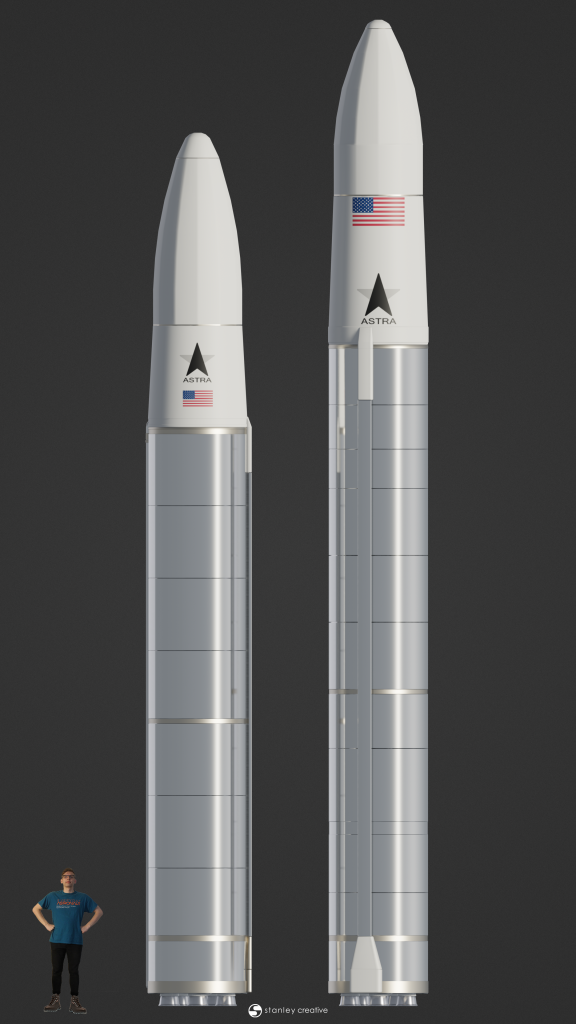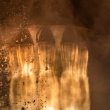Featured image credit: Astra / Brady Kenniston
Lift Off | March 15, 2022 – 16:22 UTC | 08:22 AKST |
|---|---|
Mission Name | Astra-1, Spaceflight Inc.’s first dedicated launch with Astra |
Launch Provider | Astra |
Customer | Spaceflight Inc. |
Rocket | Rocket 3.3 – LV0009 |
Launch Location | Launch Pad 3B, Pacific Spaceport Complex in Kodiak, Alaska |
Payload mass | Unknown, up to ~50 kg (~110 lb) |
Where did the payloads go? | To a 525km Sun-synchronours orbit at 97.5° inclination |
Did they attempt to recover the first stage? | No, this is not a capability of Astra |
Where did the first stage land? | The first stage crashed into the Pacific Ocean |
Did they attempt to recover the fairings? | No, this is not a capability of Astra |
Were these fairings new? | Yes |
This was the: | – 2nd launch for Astra in 2022 – 4th commercial launch for Astra – 6th launch of an Astra Rocket 3 – 27th orbital launch attempt of 2022 (26th successful) |
Where to re-watch | NASA Spaceflight’s official livestream Live updates on Astra’s Twitter account |
How Did It Go?
After scrubbing their first launch attempt on March 14, 2022 due to bad weather at the launch site, Astra has successfully launched their Rocket 3.3, designated LV0009, to orbit for the second time in Astra’s launch history. The rocket, with the mission Astra-1 on board, took off from Launch Pad 3B, Pacific Spaceport Complex in Kodiak, Alaska at 16:22 UTC on March 15, 2022. This markes Astra’s sixth launch of their Rocket 3.3 and the companies second time they’ve achieved orbit, with its previous launch – ELaNa 41 – being the company’s 4th failure during an orbital launch attempt.

Astra-1
Astra-1, or Spaceflight Astra-1, is Spaceflight Inc.’s first dedicated launch with Astra. On board were two known payloads and a number of undisclosed ones. Spaceflight Inc. is a company that specialized on procuring and organizing rides to space for payloads from companies or organizations that don’t have the resources, capabilities or don’t want to go through the hustle of launch preparations.
Objects placed into orbit during the Astra-1 launch:
- S4 CROSSOVER
- OreSat0
- 18 cataloged unknown objects
S4 CROSSOVER
NearSpace Launch’s S4 CROSSOVER is a permanently to the second stage attached prototype of the company’s future payload host plattform. The technology demonstration’s mission is to obtain flight heritage, test critical key systems, and verify its design. The plattform is independent from LV0009’s second stage and activated shortly after second stage engine cutt off. On Board are space environmental instruments to gather information on radiation and plasma density to better know and understand the environment future payloads will be exposed to. Furthermore, the host plattform is equipped with a Globalstar transmitter and an Iridium transceiver, which will be tested as well.
OreSat0
Previously scheduled to launch on SpaceX’ Transporter-3 mission, OreSat0 is a 1U CubeSat designed and built by students from Portland State University. OreSat0, Oregon’s first satellite, is an open source test bed for their upcoming 2U OreSat bus and functions as a technology demonstration to built flight heritage and operating experience. OreSat is part of NASA’s CubeSat Launch Initiative (SCLI) with a global climate science and STEM outreach mission. The satellite will feature instruments to measure the global distribution of high altitude cirrus clouds. Teams hope to refine climate models with the obtained data.
Potential SpaceBees from Swarm Technologies
Besides the previously stated known payloads, there was an undisclosed number of payloads from at least one undisclosed customer that hitched a ride on Astra-1. Experts like Jonathan McDowell believe that 16 out of 18 unknown, but cataloged objects associated with the Astra-1 launch could be Swarm Technologies‘ SpaceBees. The 1/4U IoT (Internet of Things) satellites are extremely lightweight and would definitely fit the payload capability of Astra’s Rocket 3.3. Those SpaceBees would most likely account for 16 out of the 18 unknown objects, with the two remaining unknown objects being either other payloads or pieces of debris that are the result of the this mission.
Mission Timeline*
| HH:MM:SS From Lift Off | Events |
|---|---|
| T-01:15:00 | Start of pre-launch procedure |
| T-00:45:00 | Propellant load begins |
| T-00:20:00 | Propellant load complete |
| T-00:15:00 | Entering terminal count |
| T-00:15:00 | Water deluge system test |
| T-00:00:03 | Ignition! |
| T+-00:00:00 | Lift Off! |
| T+00:00:06 | Begin Pitch Over |
| T+00:01:10 | MaxQ |
| T+00:03:00 | Main Engine Cut Off (MECO) |
| T+00:03:05 | Fairing separation |
| T+00:03:10 | Stage separation |
| T+00:03:15 | Second stage ignition |
| T+00:08:40 | Second Engine Cut Off (SECO) |
| T+00:08:50 | Payload deployment signal |
Astra’s Rocket 3.3
This Rocket 3.3, also known as LV0009 (Launch Vehicle 0009), was only their 4th Rocket 3.3 rocket despite its name. The Rocket 3 series is Astra’s orbital rocket series with LV0009 being their 9th rocket overall. With a height of 13.1 m (43 ft), a diameter of 1.32 m (4.3 ft), and a payload capacity of approximately 50 kg to a 500 km Sun-Synchronous Orbit (SSO), it is in the same class of small-sat launch vehicles as Rocket Lab’s Electron.

This two-stage rocket is powered by RP-1 and LOx. The first stage will make use of five electric-pump-fed Delphin engines that will produce a total thrust of ~145 kN (~32,500 lbf) at liftoff. The second stage is powered by a single pressure-fed Aether engine that will produce ~3.3 kN (740 lbf) of thrust in a vacuum. Since Astra is a rather secretive company, they have not released any technical information about their engines, such as ISP (Specific Impulse), TWR (Thrust to Weight Ratio), or combustion chamber pressure. The aluminum body and tanks of Rocket 3 have some similarities to SpaceX’s Starships, with its welded stacked rings of stainless steel.
Another unique characteristic is that Astra’s Rocket 3 series rockets fit into a standard shipping container and can be towed by a truck. To set up the rocket on its mobile launch structure, it only takes a handful of ground support staff and about a week to go through vehicle checks, a wet dress rehearsal, and the launch readiness review. Astra’s goal for the future is to bring the time required to set up the rocket down to under 24 hours, so that it can meet the needs of some special customers who require a rapid launch schedule for their payloads.
Differences To Earlier Rocket 3 Series Rockets
Astra have upgraded their series 3 rockets launch after launch, and the same is true for LV0009. After the failed flight of LV0008, Astra implemented following changes to ensure a successful flight:
- End-of-line signal test to prevent similar issues (mixed up harness channels on fairings)
- Trio of software updates to prevent loss of gimbal capability on second stage
Previously, Chris Kemp, CEO of Astra, has stated in an interview with NASA Spaceflight that going from LV0005 to LV0006, they have stretched the first stage tanks for more performance.

Earlier Losses
Astra has launched two orbital class rockets in an attempt to reach orbit. So far, all of these launches have failed to achieve orbit, with the latest, Rocket 3.2, just barely missing orbit by about 500 m/s. Its second stage safely re-entered before completing one full rotation of Earth.
- Rocket 3.0: loss of the vehicle during ground testing due to a stuck open valve while detanking the vehicle.
- Rocket 3.1: FTS activated 21s into flight due to a software issue in the guidance system.
- Rocket 3.2: Rocket 3.2 failed to achieve orbit by ~500 m/s due to a wrong mixture of fuel and oxidizer on the second stage.
- Rocket 3.3: LV0006 was terminated at T+2:31 after one of the engines experienced a failure less than 1s after ignition due to the ignition of leaking fuel and oxidizer in the propellant supply system, better known as a quick disconnect, at the base of the rocket.
- Rocket 3.3: LV0008 was lost after failed fairing separation, with its second stage breaking through the not released fairings spinning out of control due to a software issue preventing the TVC system to gimbal the engine.





